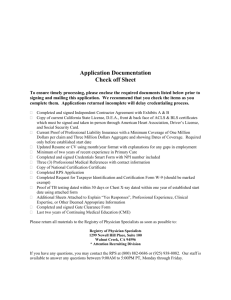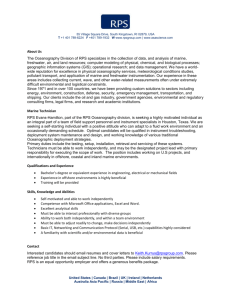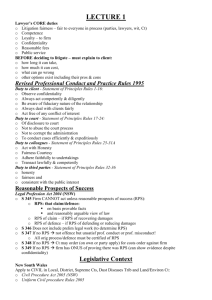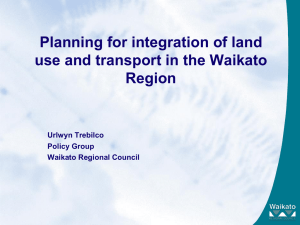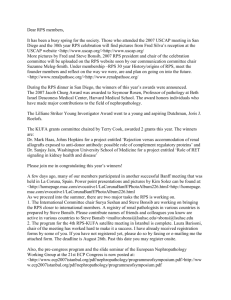A RACE TO RENEW: EXPLAINING THE RISE OF RENEWABLE PORTFOLIO
advertisement
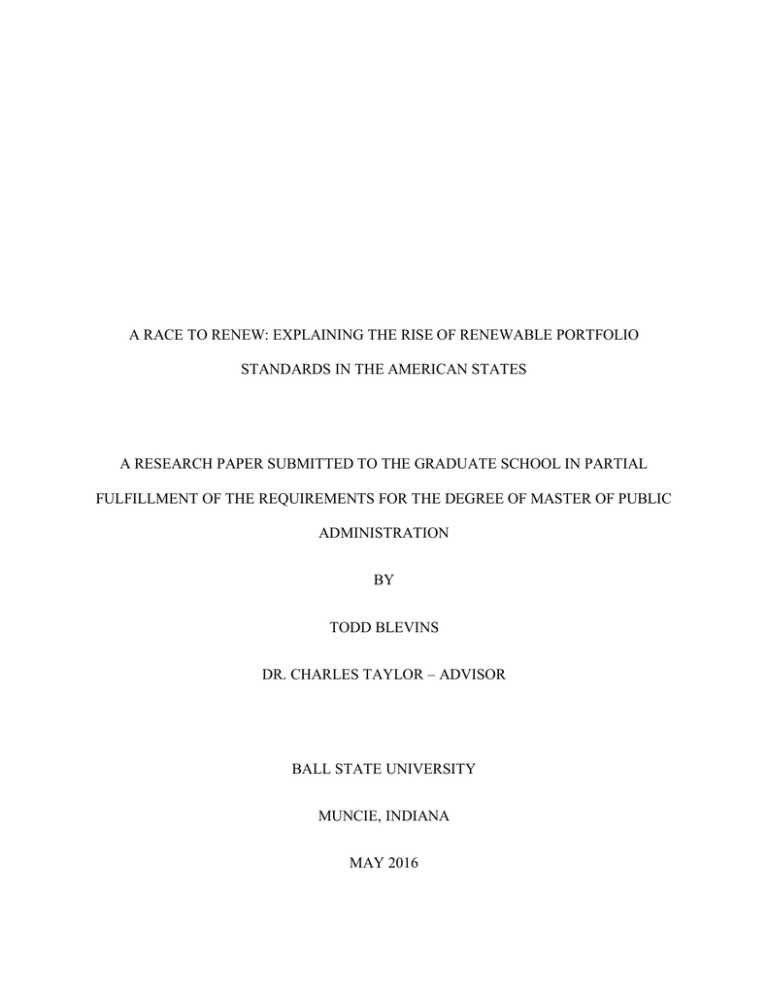
A RACE TO RENEW: EXPLAINING THE RISE OF RENEWABLE PORTFOLIO STANDARDS IN THE AMERICAN STATES A RESEARCH PAPER SUBMITTED TO THE GRADUATE SCHOOL IN PARTIAL FULFILLMENT OF THE REQUIREMENTS FOR THE DEGREE OF MASTER OF PUBLIC ADMINISTRATION BY TODD BLEVINS DR. CHARLES TAYLOR – ADVISOR BALL STATE UNIVERSITY MUNCIE, INDIANA MAY 2016 Introduction Faced with growing concerns surrounding climate change, peak oil, and other energy and environmental issues, many nations have begun to transition away from fossil fuels to renewable energy sources to meet their energy needs. At the 2015 Paris Climate Conference (COP21), 195 countries adopted the first-ever universal agreement to reduce carbon dioxide emissions across the globe (UNFCC, 2015). Among the signatories to this so-called Paris Agreement was the United States. The inclusion of the U.S., the world’s second-leading carbon polluter, was seen as instrumental to legitimizing the agreement (recall that the U.S. withdrew from the 1997 Kyoto Protocol in 2001). In addition to signing this agreement, the U.S. has made other strides to reduce its carbon output. On August 3, 2015, the U.S. Environmental Protection Agency (EPA), with the support of President Barack Obama, unveiled the Clean Power Plan, which aims to reduce carbon dioxide emissions from power plants by 32 percent in 2030 relative to 2005 levels (EPA, 2015a). However, on February 9, 2016, the U.S. Supreme Court moved to temporarily block the implementation of the Clean Power Plan. Despite these initiatives to reduce carbon pollution, the U.S. has yet to pass significant legislation to expand renewable energy production, which would serve to meet the carbonpollution mitigation goals of the Paris Agreement and Clean Power Plan. In his 2011 State of the Union address, President Obama called on Congress to establish a national clean energy standard of 80 percent clean energy by 2035 (Carley, 2012), yet Congress took no such action. In the absence of federal action, it has been left to the states to encourage renewable energy expansion through renewable portfolio standards (RPS) and other means. 1 Renewable portfolio standards are designed to produce a certain percentage or amount (MW) of a state’s electricity output through renewable sources, such as wind, solar, or biomass. RPS may apply to public- and/or investor-owned utilities (IOUs) in the state. As of 2016, thirty states have a mandatory RPS, with another eight states having established voluntary renewable standards or goals (Kansas repealed its RPS in 2015 in favor of a voluntary renewable goal) (Durkay, 2016). Table 1 demonstrates the high degree of variation in states’ mandatory RPS. For instance, while Hawaii requires 100 percent renewable energy by 2045, South Carolina only requires 2 percent by 2021. In addition to these variations in requirements, state RPS also vary in terms of qualifying sources. Several states include energy efficiency programs in their RPS while others offer multipliers for certain technologies (e.g., solar photovoltaic cells). Table 1. States with Mandatory Renewable Portfolio Standard State Established 2006 Requirement 15% by 2025 California 2002 Colorado 2004 Connecticut 1998 33% by 2020 40% by 2024 45% by 2027 50% by 2030 30% by 2020 (IOUs) 10% or 20% for municipalities (munis) and electric cooperatives (co-ops), depending on size 27% by 2020 Delaware 2005 25% by 2025-2026 Hawaii 2001 Illinois 2007 30% by 2020 40% by 2030 70% by 2040 100% by 2045 25% by 2025-2026 Iowa 1983 Kansas1 2009 Maine 1999 105 MW of generating capacity for IOUs 15% by 2015-2019 20% by 2020 40% by 2017 Maryland 2004 20% by 2022 Arizona 2 Massachusetts2 1997 Michigan3 2008 Minnesota 2007 Missouri 2007 26.5% by 2025 (IOUs) 25% by 2025 (other utilities) 15% by 2021 (IOUs) Montana 2005 15% by 2025 Nevada 1997 25% by 2025 New Hampshire 2007 24.8% by 2025 New Jersey 1999 24.5% by 2020 New Mexico 2002 New York 2004 North Carolina 2007 Ohio4 Oregon 2008 2007 Pennsylvania 2004 20% by 2020 (IOUs) 10% by 2020 (co-ops) 29% by 2015 50% by 2030 12.5% by 2021 (IOUs) 10% by 2018 (munis and coops) 25% by 2026 25% by 2025 (utilities with >3% of state’s electricity output) 10% by 2025 (1.5%-3%) 5% by 2025 (<1.5%) 18% by 2020-2021 Rhode Island 2004 14.5% by 2019 South Carolina 2014 2% by 2021 Texas 1999 Vermont 2015 Washington 2006 Wisconsin 1998 Class I: 15% by 2020 and an additional 1% each year thereafter Class II: 5.5% by 2015 10% by 2015 5,880 MW by 2015 10,000 MW by 2025 55% by 2017 75% by 2032 9% by 2016 15% by 2020 10% by 2015 Source: Durkay, 2016. 1. Kansas repealed its RPS in 2015 in favor of a renewable energy goal but will be treated as an adopter in this study. 2. Massachusetts: Class I resources are new sources. Class II resources were in operation by 1997. 3. Michigan: The state’s largest two utilities have additional requirements beyond the 10% statewide requirement (600 MW by 2015 for DTE Electric, 500 MW by 2015 for Consumers Energy). 4. Ohio: RPS is currently on a two-year freeze while a panel studies the costs and benefits of the requirement (SB 310). 3 Despite these differences, it remains essential to examine the expansion of RPS throughout the country, especially given their recent proliferation. Of the 30 mandatory RPS among states, 12 have been enacted in the last decade alone. Given this recent proliferation, it is important to consider internal determinants within a state as well as the effects of diffusion mechanisms to determine what could be attributed to this increase. Specifically, this study will seek to answer the following: Why do states adopt renewable portfolio standards? It is important to answer this question as the U.S. continues to transition to renewable energy and state policymakers seek to determine whether a RPS is suitable for their state. This study is composed of seven sections. The first section will consider theories in the existing literature of RPS adoption related to the internal determinants and diffusion models. The second section will present hypotheses based on these models. The third section will outline the methods used in assembling and testing relevant data. The fourth section will examine the results of a logistic regression analysis and highlight noteworthy findings. The fifth section will offer a thorough discussion of these results as they relate to the proposed hypotheses. The sixth section will explore the limitations and future directions of this research. The seventh section will consider what the future of RPS may hold. Literature Review Among previous studies of the factors related to RPS adoption, several internal determinants and diffusion mechanisms have been shown to have a significant effect. Each of these studies has contributed to a growing knowledge of potential causes behind the adoption of RPS by states. While multiple authors have suggested that national socio-economic and political conditions also affect state policy decisions (Rose, 1973; Sharkansky, 1968), such a suggestion is 4 outside the scope of this study and indeed outside the scope of the existing literature on the subject of RPS adoption. To maintain a state-level focus, this study will focus on internal determinants within a state and diffusion models based on the presence of RPS in surrounding states. Internal Determinants Model The internal determinants model can be effectively applied to explain RPS adoption as well as other environmental policies. Feiock and West (1993) consider several internal determinants in explaining causes for adoption of municipal solid waste recycling programs, including administrative capacity, need responsiveness, and others. In analyzing the strength of air pollution control in various states, Ringquist (1994, 1993) develops a model integrating economic, political, and interest group influences on the state pollution-control process. In the case of “green electricity” policies like RPS, Vachon and Menz (2006) have developed the most appropriate typology for classifying internal determinants affecting adoption. The authors classified internal determinants as social, political, or economic. Social variables such as education and participation in environmental interest groups represent the motivations of voters in the adoption of “green electricity” policies. Political variables such as voting records reflect the motivations of elected officials in this process. Finally, economic variables such as industry type and fossil-fuel consumption in a state highlight the motivations of industry and industry-affiliated groups in this process. Using the Vachon and Menz (2006) typology as a framework, this study will classify internal determinants as (1) social, (2) political, or (3) economic. 5 Social Determinants Air Quality. Lyon and Yin (2010) note that the environmental benefits of RPS, most notably a reduction in air pollution, may be especially attractive to states with poor air conditions. Furthermore, Jenner et al. (2012) argue that air pollution is a negative externality brought on by market failure that policymakers could remedy through RPS. Both Chandler (2009) and Matisoff (2008) have found that poor air quality in a state has a positive effect on RPS adoption. Education Level. Huang et al. (2007) argues that a greater level of education translates into a greater awareness of the environmental consequences of fossil fuel use. Vachon and Menz (2006) propose a similar argument and add that a greater education level contributes to a greater understanding of the costs and benefits of different energy policies. Both Huang et al. (2007) and Vachon and Menz (2006) have found that the average education level of a state has a significant impact on RPS adoption. Political Determinants Democratic Control of State Legislature. Several studies have theorized that Democratic control over the state legislature has a significant effect on RPS adoption. As Chandler (2009) notes, state legislatures are not the only body to adopt RPS, as some may come through regulations or referenda, but most are legislated. While Huang et al. (2007) assert that environmental milestones in U.S. history have occurred under both Democratic and Republican administrations, several other authors have found that Democratic Party control in a state leads to a greater willingness to take on environmental initiatives. Lester and Lombard (1990) find that Democratic partisanship is strongly related to environmental voting within state legislatures. 6 Moreover, both Lyon and Yin (2010) and Chandler (2009) have found that a greater number of state legislature seats occupied by Democrats leads to greater support for a RPS. Pro-Environment Voting by Congressional Delegation. Lyon and Yin (2010) maintain that the environmental voting record of a state’s congressional delegation serves as a proxy for the environmental preferences of citizens in the state, as political actors typically view their own ideologies as altruistic expressions of concern with public interest. Moreover, Vachon and Menz (2006) argue that a pro-environment voting record leads to greater support for a RPS and other “green electricity” policies at the state level. Vachon and Menz (2006) have found the relationship between a pro-environment voting record by a state’s congressional delegation and RPS adoption to be positive and significant. Economic Determinants Gross State Product Per Capita. Several studies (Jenner et al., 2012; Matisoff, 2008; Huang et al., 2007; Vachon and Menz, 2006) note that GSP is the most appropriate measure of state fiscal capacity. Moreover, Matisoff (2008) writes GSP per capita is the most appropriate measure of fiscal capacity for individuals within a state. Matisoff (2008) notes that states with a higher GSP per capita can partake in policy experimentation due to a fiscal ability to implement costly public programs. In addition, Vachon and Menz (2006) note that a higher GSP per capita could lead to greater support for often-costly “green electricity” policies like a RPS, as sensitivity to the perceived costs of such policies diminishes with a higher GSP per capita. Huang et al. (2007) have found that GSP has a significant impact on RPS adoption, yet GSP per capita has thus far failed to achieve significance in a study. 7 Coal/Oil/Natural Gas Consumption. Previous studies have considered the notion that a state with high fossil-fuel consumption would be less likely to support a RPS. On one hand, high fossil-fuel consumption may reflect the presence of a fossil fuel-intense industry, such as chemical or paper production, in a state. The presence of this industry may lead to greater economic adjustments and political opposition to a RPS in the state (Chandler, 2009). Furthermore, high fossil-fuel consumption could be matched by high fossil-fuel employment (Lyon and Yin, 2010). Irrespective of the source of RPS opposition from fossil fuel-affiliated industries, multiple studies have theorized that high fossil-fuel consumption in a state leads to greater opposition to RPS adoption (Lyon and Yin, 2010; Chandler, 2009; Matisoff, 2008; Huang et al, 2007; Vachon and Menz, 2006). However, only Lyon and Yin (2010) have found fossil-fuel consumption to be statistically significant. This study will examine the respective effects of coal, oil and natural gas consumption on RPS adoption. Electricity Prices. Studies have only begun to consider the effect state electricity prices may have on RPS adoption. Roe et al. (2001) have found that U.S. energy consumers are willing to pay a premium for electricity from sources with minimal impact on air quality while Zarnikau (2003) concludes that consumers who are educated, affluent, and/or under the age of 55 are more willing to pay a premium for “green power.” Nevertheless, few studies have analyzed how electricity prices affect RPS support. Lyon and Yin (2010) write that high electric prices may reflect the need for a state to seek out alternative energy sources, yet it may be more difficult to pass on the extra costs of these sources to consumers whose electric prices are already high. In addition, Jenner et al. (2012) considered how electricity prices may affect RPS adoption in the European Union. It is worth noting that neither study has found electricity prices to have a 8 significant impact on RPS adoption. This study hopes to fill this gap in the literature to expand upon existing theories of RPS adoption. State Unemployment Rate. Rabe (2007) finds that one of the biggest reasons RPS adoption has spread throughout the U.S. is that it is compatible with the predominant state goal of promoting economic development; that is, a RPS may stimulate job creation in a state. In this vein, multiple studies have considered the role of a state’s unemployment rate in RPS adoption. Lyon and Yin (2010) find that states with high unemployment rates are in fact less likely to adopt a RPS. On the other hand, Jenner et al. (2012) find that a high unemployment rate increases the likelihood of RPS adoption in the European Union. Despite these conflicting findings, it seems logical to suggest that RPS would spur job growth. In fact, Jenner et al. (2012) themselves note that renewable investment, brought on in part by RPS adoption, has created 550,000 new jobs in Europe since 1990. Diffusion Model In their seminal work on policy innovation, Berry and Berry (2007) present a model of policy diffusion based on emulative behavior by states. As the authors explain, the diffusion model is based on the theory that governments are influenced primarily by other governments that are geographically proximate. Specifically, there are three levels of diffusion—neighbor, regional, and national, with each type varying in geographic scope. While neighbor diffusion in the United States only considers the policy decisions of neighboring states, regional diffusion considers the policy decisions of all states within a region (Northeast, Midwest, etc.) and national diffusion considers the policy decisions of all states in the country. According to the diffusion model, a state may emulate the policy decision of one or more states for one of three reasons: (1) 9 to learn from the other(s), (2) to avoid competing with the other(s), or (3) to conform with the other(s). This study will consider these premises as they relate to the theory of geographic proximity in the diffusion model. Neighbor/Regional Diffusion. Multiple authors have applied the diffusion model developed by Berry and Berry (2007) to RPS adoption. Specifically, Chandler (2009) finds that all three levels of diffusion have a positive and significant effect on RPS adoption. Moreover, Jenner et al. (2012) reach a similar conclusion when applying the work of Chandler (2009) to the European Union. Matisoff (2008) finds that regional diffusion has a particularly positive effect on RPS adoption, as exemplified by the Regional Greenhouse Gas Initiative (RGGI) and Western States Climate Change Initiative (WSCCI). This study will focus on neighbor and regional diffusion to highlight how RPS adoption in one state impacts RPS adoption in geographically-proximate states. Theory Having considered the work of the authors mentioned above, it is clear that internal determinants and/or diffusive models have a significant effect on RPS adoption. Nevertheless, there remain gaps in the literature concerning causal factors. For instance, few studies have considered the role that electricity prices might play in RPS adoption. Furthermore, it would appear that no studies of RPS adoption in the U.S. have been conducted since 2010, which is especially problematic given the rapid proliferation of RPS across the U.S. This study will seek to build upon existing theories of RPS adoption and update the application of these theories to match the expansion of RPS since 2010. 10 Hypotheses Air Quality. With respect to the findings of previous authors (Jenner et al., 2012; Lyon and Yin, 2010; Chandler, 2009; Matisoff, 2008) concerning air quality, one can hypothesize the following: H1: States with poor air quality are more likely to adopt a RPS. Education Level. With respect to the findings of previous authors (Huang et al., 2007; Vachon and Menz, 2006) concerning education level, one can hypothesize that: H2: States with a higher education level are more likely to adopt a RPS. Democratic Control of State Legislature. With respect to the findings of previous authors (Lyon and Yin, 2010; Chandler, 2009; Huang et al., 2007) concerning Democratic control of state legislature, one can hypothesize that: H3: States with Democratic control of the state legislature are more likely to adopt a RPS. Pro-Environment Voting by Congressional Delegation. With respect to the findings of previous authors (Lyon and Yin, 2010; Vachon and Menz, 2006) concerning pro-environment voting by a state’s congressional delegation, one can hypothesize that: H4: States whose congressional delegation has a pro-environment voting record are more likely to adopt a RPS. GSP Per Capita. With respect to the findings of previous authors (Jenner et al., 2012; Matisoff, 2008; Huang et al., 2007; Vachon and Menz, 2006) concerning GSP per capita, one can hypothesize that: 11 H5: States with a higher GSP per capita are more likely to adopt a RPS. Coal/Oil/Natural Gas Consumption. With respect to the findings of previous authors (Lyon and Yin, 2010; Chandler, 2009; Matisoff, 2008; Huang et al., 2007; Vachon and Menz, 2006) concerning fossil-fuel consumption, one can hypothesize that: H6: States with higher coal consumption are less likely to adopt a RPS. H7: States with higher oil consumption are less likely to adopt a RPS. H8: States with higher natural gas consumption are less likely to adopt a RPS. Electricity Prices. Though the effect of state electricity prices on RPS adoption remains inconclusive (Jenner et al., 2012; Lyon and Yin, 2010; Zarnikau, 2003; Roe et al., 2001), one can hypothesize that: H9: States with higher electricity prices are less likely to adopt a RPS. State Unemployment Rate. With respect to the findings of previous authors (Jenner et al., 2012; Lyon and Yin, 2010; Rabe, 2007) concerning state unemployment rate, one can hypothesize that: H10: States with higher unemployment rates are more likely to adopt a RPS. Neighbor/Regional Diffusion. With respect to the findings of previous authors (Jenner et al., 2012; Chandler, 2009; Matisoff, 2008) concerning neighbor and regional diffusion, one can hypothesize that: H11: States whose neighbors have adopted a RPS are more likely to adopt a RPS. 12 H12: States that exist in a region where a majority of states have adopted a RPS are more likely to adopt a RPS. Methodology The methods utilized here build upon those of previous authors. Sabatier and JenkinsSmith (1999) recommend using a period at least of ten years to evaluate major policy change. Therefore, this analysis will employ a ten-year average of data on independent variables where appropriate and feasible based on available data. For those states with a RPS, this study will utilize a ten-year average of data up to the year of adoption. For instance, if a state adopted a RPS in 2004, this study will examine available data on independent variables from 1995-2004. For those states without a RPS, this study will utilize the most recent ten-year data set (20062015) where possible. In those instances where a ten-year data set is not available, the analysis will employ a shorter multi-year average. Further, as previous authors have sought to find data for all variables prior to most states adopting a RPS, this study will seek to do the same. However, this is not attainable in all instances. In these instances, this study will utilize available data. A logistic regression will be conducted to evaluate the respective effect of each independent variable on RPS adoption. This regression will be performed to determine statistical significance at the .1 (90%), .05 (95%) and .01 (99%) levels. A description of these variables can be found in Table 2. 13 Table 2. Description of Variables. Variable RPS NONATTN BACHPOP DEMCNTRL CONSRV GSPCAP COAL OIL NATGAS ELETRC UNEMPLY NGHDIFF REGDIFF N = 49 Adoption of Renewable Portfolio Standard EPA nonattainment State pop w/Bach degree or higher (%) Dem control of state leg. LCV scores (%) GSP per capita ($/1000) Coal consumption (short tons) Oil consumption (barrels) Natural gas consumption (Mcf) Electricity prices (cents/kWh) State unemployment rate (%) RPS adoptions among neighbors RPS adoptions in census region Minimum Maximum Mean 0 0 16.75 0 7 31.646 .00 .00 .00 5.13 3.25 0 0 1 1 35.8 1 95 67.332 93.84 30.87 1414.3 14.88 8.25 4.5 8.9 .61 .80 26.86 .37 44.79 44.42 19.70 3.27 121.92 8.02 5.60 1.35 3.65 Std. Dev. .492 .407 4.420 .487 25.703 7.654 19.389 6.218 252.106 2.049 1.218 1.225 2.42 Dependent Variable Adoption of RPS. The dependent variable measured here is the adoption of RPS by a state. A state will not be included in the analysis for the years following RPS adoption. Because Iowa adopted its RPS in 1983, well before all other states (see Table 1), it will not be included in this analysis (Lyon and Yin, 2010). Data on year of RPS adoption is made available through the National Conference of State Legislatures (NCSL). States are coded as 0 if they have not adopted a RPS and 1 if they have adopted a RPS. Independent Variables Air Quality. The degree of air quality in a state is measured by a ten-year average within a twenty-four-year (1992-2015) data set of whether part of a state was listed as a non-attainment area in a given year for one or more of the EPA’s “criteria pollutants,” such as carbon monoxide (CO), sulfur dioxide (SO2), or lead (Chandler, 2009). Data on non-attainment is made available 14 in the EPA Green Book, which is published annually. States without and with non-attainment status in a given year are coded as 0 and 1, respectively. Education Level. The education level of a state is measured by averaging the two most recent data points of the percentage of a state’s population 25 years old and over with a Bachelor’s degree within a twenty-one-year (1990-2010, every four years) data set (Huang et al., 2007). Data on educational attainment is made available via the National Center for Education Statistics. Democratic Control of State Legislature. Democratic control of the state legislature is measured by a ten-year average within a twenty-five-year (1988-2012, every two years) data of whether the Democratic Party controlled both houses of the state legislature (Lyon and Yin, 2010; Huang et al., 2007). Data on party control of the state legislature is made available by the NCSL. States are coded as 1 for average Democratic control of the state legislature over this period and 0 for either Republican or split party control. Pro-Environment Voting by Congressional Delegation. The environmental voting record of a state’s congressional delegation is measured by combining the ten-year average within a twentysix-year (1989-2015) data set of a state’s senate and house delegation scores on the League of Conservation Voters’ (LCV) National Environmental Scorecard (Lyon and Yin, 2010; Vachon and Menz, 2006). GSP Per Capita. Ten-year averages of GSP per capita are made available within an eighteen-year (1997-2014) data set by the U.S. Bureau of Economic Analysis (BEA) (Matisoff, 2008; Vachon and Menz, 2006). GSP per capita averages are divided by a factor of 1000 to produce a more measurable change in the variable. 15 Coal/Oil/Natural Gas Consumption. State fossil-fuel consumption can be measured by a ten-year average within a twenty-five-year (1990-2014) data set of the total units of coal, oil and natural gas consumed by a state’s electric power industry. Coal consumption is measured in short tons; oil consumption is measured in barrels; and natural gas consumption is measured in thousands of cubic feet (Mcf). Data on annual fossil fuel consumption is made available by the U.S. Energy Information Administration (EIA). Electricity Prices. State electricity prices for all sectors are measured by a ten-year average within a twenty-five-year (1990-2014) data set of cents per kilowatt hour (kWh) (Lyon and Yin, 2010). Data on price/kWh rates is made available by the U.S. EIA. State Unemployment Rate. Ten-year averages within a twenty-four-year (1992-2015) data set of state unemployment rates are made available by the U.S. Bureau of Labor Statistics (BLS) (Lyon and Yin, 2010). Neighbor/Regional Diffusion. Ten-year averages within a nineteen-year data set (1997-2015) of neighbor diffusion are measured by the number of RPS adoptions among a state’s neighbors in a given year. Ten-year averages within a nineteen-year data set (1997-2015) of regional diffusion are measured by the number of RPS adoptions in a census region in a given year (Northeast, Midwest, South and West) (Chandler, 2009). 16 Results A logistic regression was performed to determine the effects of air quality (NONATTN), education level (BACHPOP), Democratic control of state legislature (DEMCNTRL), proenvironmental voting by congressional delegation (CONSRV), GSP per capita (GSPCAP), coal consumption (COAL), oil consumption (OIL), natural gas consumption (NATGAS), electricity prices (ELETRC), state unemployment rate (UNEMPLY), neighbor diffusion (NGHDIFF) and regional diffusion (REGDIFF) on the likelihood of RPS adoption by a state. The results of this regression are presented in Table 3. 17 Table 3. Logistic Regression Results. Variable Coef. NONATTN 1.859 (1.485) .001 (.238) BACHPOP DEMCNTRL GSPCAP -2.547 (2.073) .138** (.068) -.209 (.159) COAL .014 (.041) OIL -.137 (.130) NATGAS .000 (1.000) .012 (.580) -1.165* (.674) CONSRV ELETRC UNEMPLY NGHDIFF -2.234** (1.019) CONSTNT 13.229 (9.090) Pseudo R2 Predicted .758 87.8% N 49 ***p<.001, **p<.05, *p<.1. Standard errors in parentheses. Note: REGDIFF is excluded from this analysis, as the logistic regression was unable to find a solution when REGDIFF was included in the analysis. The model’s pseudo R2 value of .758 indicates that it would be able to explain 75.8% of the variance in RPS adoption. Furthermore, the model was able to correctly classify 87.8% of the cases. LCV scores were found to be statistically significant at the .05 (95%) confidence level with a coefficient value of .138. This supports the hypothesis that higher LCV scores increase the likelihood of RPS adoption in a state. State unemployment rate was found to be statistically significant at the .1 (90%) confidence level with a coefficient value of -1.165. This suggests that 18 higher state unemployment rates decrease the likelihood of RPS adoption, which is in contrast to the hypothesis that states with higher unemployment rates will be more likely to adopt a RPS. Finally, neighbor diffusion was found to be statistically significant at the .05 level with a coefficient value of -2.234. This indicates that neighbor diffusion has a negative impact on RPS adoption, which directly opposes the hypothesis that a higher number of RPS adoptions among a state’s neighbors will increase the likelihood of RPS adoption in a state. Table 4 shows the odds ratios for each variable in the logistic regression. The results indicate that for every one-unit increase in LCV scores, there is a 14.8% increase in the odds of RPS adoption, holding all other variables constant. Conversely, for every one-unit increase in state unemployment rate, there is a 68.8% decrease in the odds of RPS adoption, holding all other variables constant. Finally, for every one-unit increase in neighbor diffusion, there is a 89.3% decrease in the odds of RPS adoption, holding all other variables constant. Table 4. Odds Ratios. Variable Exp(B) NONATTN 6.420 BACHPOP 1.001 DEMCNTRL .078 CONSRV 1.148** GSPCAP .812 COAL 1.014 OIL .872 NATGAS 1.000 ELETRC 1.012 UNEMPLY .312* NGHDIFF .107** CONSTNT 556529.763 ***p<.001, **p<.05, *p<.1. 19 Tables 5 and 6 depict the classification of states without and with predictor variables, respectively. As Table 5 indicates, the model was correctly able to classify 61.2% of states with no predictor variables. Table 6, on the other hand, indicates that the model was able to correctly classify 87.8% of states when predictor variables are added. This means that by adding the predictor variables considered in this study, the model was able to improve its accuracy by 26.6%. Table 6 also indicates that, with predictor variables, the model was able to correctly classify 27 of the 30 states with a RPS, giving it a sensitivity of 90%. Conversely, the model was able to correctly classify 16 of the 19 states without a RPS, giving it a specificity of 84.2%. The model was also able to correctly classify 16 states without a RPS while misclassifying 3 states without a RPS, giving it a negative predictive value of 84.2%. On the other hand, the model was able to correctly classify 27 states with a RPS while misclassifying 3 states with a RPS, giving it a positive predictive value of 90%. Table 5. Classification of Cases (No Predictors). Observed No RPS RPS Predicted No RPS RPS 0 19 0 30 Overall Percentage Percentage Correct 0 100 61.2 Table 6. Classification of Cases (With Predictors). Observed No RPS RPS NPV PPV Predicted No RPS 16 3 RPS 3 27 Percentage Correct 84.2 90.0 84.2% 90% Overall Percentage 20 87.8 Discussion Several of the predictor variables tested in this analysis proved insignificant. EPA nonattainment status was determined to be insignificant, but its positive coefficient value nevertheless suggests that states with poor air quality, at least as measured by EPA nonattainment status, would theoretically be more likely to adopt a RPS. Bachelor’s degree attainment in a state was also determined to be insignificant, yet its coefficient value is rather miniscule. This suggests that education level may not have a substantial impact on RPS adoption. The negative coefficient associated with Democratic control of the state legislature runs contrary to the theory that Democrats are more likely to support a RPS than Republicans. In fact, while Democratic control of the state legislature proved insignificant, the results suggest that a Republican or split legislature is just as likely to pass a RPS as is a Democratic legislature. GSP per capita proved both insignificant and negative, suggesting that the environmental concerns of wealthier states may not differ much from those of their less-wealthy counterparts. Moreover, none of coal, oil or natural gas was deemed to be significant, and their small coefficient values suggest a change in fossil-fuel consumption would have little effect on RPS adoption. Finally, state electricity prices also proved insignificant, suggesting that the ambiguity surrounding the effect of electricity prices on RPS adoption is likely to persist. On the other hand, a pro-environmental voting record by a state’s congressional delegation—as measured by LCV scores—was found to be significant in this analysis. This supports the theory that a congressional delegation’s LCV scores serve as a proxy for the environmental concerns of a state’s citizens. Matisoff (2008) notes that citizen preferences are often a strong indicator of environmental policy voting. According to this theory, higher LCV 21 scores reflect a citizenry with a favorable attitude toward environmental initiatives like a RPS. Indeed, this seems to be the case here, as increasing LCV scores indicate a greater likelihood of RPS adoption. State unemployment rate also achieved significance in this analysis. In fact, the results indicate that higher unemployment leads to less support for a RPS. This is a similar finding to that of Lyon and Yin (2010). Such a finding seems to undermine the notion of a RPS as a jobcreator and runs contrary to Rabe’s (2007) theory that a RPS is compatible with the idea of promoting economic development. Instead, it suggests that a “green electricity” policy like a RPS runs counter to the idea of job growth. Palmer and Burtraw (2005) write that states with higher unemployment rates have little interest in a RPS because it stands to increase electricity prices, which is an unwanted effect in a state with high unemployment. Neighbor diffusion was also found to be significant in this analysis. However, contrary to previous findings (Chandler, 2009), neighbor diffusion appears to suppress RPS adoption. Moreover, this suppressive effect appears to be substantial, as seen in the 89.3% decrease in the odds of RPS adoption for every one-unit increase in neighbor diffusion. There appear to be two possible explanations for this. First, the negative relationship between neighbor diffusion and RPS adoption could be explained by the idea of policy entrepreneurship. This idea holds that the notion of initial adopters among a group of neighbors wanting to initiate a trend (“race to the top”) is greater than that of non-adopters refusing to take part in such a trend (“race to the bottom”). Alternatively, this result could be explained by a variation in methodology. While this study used a ten-year average of RPS adoptions among neighbors, Chandler (2009) employed an event-history analysis. 22 Arguably the most impactful results of this model are its strong explanatory power and predictive accuracy. As stated, the model produced a pseudo R2 of 75.8%, indicating that the model was able to account for over three-fourths of all factors impacting RPS adoption. Furthermore, the model was able to correctly classify an additional 12 states correctly by adding the predictor variables considered in this analysis. Limitations and Future Research Despite achieving significance for three variables and producing strong explanatory power and predictive accuracy, there exist several limitations with this model. First, as stated, the model did not employ an event-history analysis. An event-history analysis would be worthwhile for all variables, especially neighbor diffusion, as it predicts the chances of RPS adoption for each state in each year rather than within a ten-year period. Future adaptations of this study may utilize an event-history analysis to both examine the odds of RPS adoption in a given year and to provide additional data points. Another shortcoming of this study is that annual data was not always available for years corresponding with RPS adoption. For instance, the National Center for Education Statistics only publishes measures of Bachelor’s degree attainment in select years. This resulted in fewer data points on Bachelor’s degree attainment and could have caused variation in the logistic regression results. In the future, one could build upon this model by adding to additional variables and considering new variables as well. For one, while this analysis did not consider the partisanship of governors, who could potentially veto RPS legislation, future adaptations of this study could include this variable under Democratic Party control. This may change some of the findings 23 associated with Democratic Party control. Moreover, LCV scores could be more precise by measuring the voting records of each individual senator or representative rather than combining the averages of the Senate and House delegations. Future adaptations of this study could also consider variables such as interest group presence, existing renewable capacity, population growth rate, and RPS policy design, all of which have been considered by multiple authors. Including these variables could build upon the already-strong explanatory power of the model. Conclusion It is clear that RPS adoption has become a widespread practice in the United States. This “race to renew” can be explained by several social, political, economic and diffusive factors, several of which were examined in this analysis. The results of this analysis indicate that a proenvironment voting record by a state’s congressional delegation, state unemployment rate, and neighbor diffusion all have a significant effect on RPS adoption. These results can be added to a growing body of literature on motivations behind RPS adoption. Nevertheless, the ambiguity and disparity in some parts of this body of literature indicate that research on the motivations behind RPS adoption must continue. What remains unclear is the future of RPS in the United States. On one hand, some authors (Sovacool, 2008; Heiman and Solomon, 2004) argue that it is time for the U.S. to move toward a national RPS to establish continuity. On the other hand, Michaels (2008, 2008) and others insist that RPS should be rejected in favor of incentive-based approaches at both the state and national levels. Additionally, the effectiveness of RPS is far from clear, as multiple authors have argued (Fischlein and Smith, 2013; Carley, 2009). While the motivations behind RPS 24 adoption must be analyzed, so too must the effectiveness of utilizing a RPS to move beyond fossil fuels and toward renewable energy. 25 Works Cited Berry, Frances Stokes, and William D. Berry. 2007. “Innovation and Diffusion Models in Policy Research.” In Theories of the Policy Process, eds. Paul A. Sabatier and Christopher Weible, second ed., 223-260. Carley, Sanya. 2012. “A Clean Energy Standard: Experience from the States.” Review of Policy Research 29: 301-307. http://onlinelibrary.wiley.com/doi/10.1111/j.15411338.2011.00553.x/abstract?userIsAuthenticated=false&deniedAccessCustomisedMessa ge (February 1, 2016). Carley, Sanya. 2009. “State Renewable Energy Electricity Policies: An Empirical Evaluation of Effectiveness.” Energy Policy 37(8): 3071-3081. Chandler, Jess. 2009. “Trendy Solutions: Why Do States Adopt Sustainable Energy Portfolio Standards?” Energy Policy 37(8): 3274-3281. doi:10.1016/j.enpol.2009.04.032 (February 1, 2016). Durkay, Jocelyn. 2016. “State Renewable Portfolio Standards and Goals.” National Conference of State Legislatures. January 15. http://www.ncsl.org/research/energy/renewableportfolio-standards.aspx (February 1, 2016). Feiock, Richard C. and Jonathan P. West. 1993. "Testing Competing Explanations for Policy Adoption: Municipal Solid Waste Recycling Programs." Political Research Quarterly 46(2): 399-419. Fischlein, Miriam and Timothy M. Smith. 2013. “Revisiting Renewable Portfolio Standard Effectiveness: Policy Design and Outcome Specification Matter.” Policy Sciences 46(3): 277-310. http://www.jstor.org.proxy. bsu.edu/stable/42636771 Heiman, Michael K., and Barry D. Solomon. 2004. “Power to the People: Electric Utility Restructuring and the Commitment to Renewable Energy.” Annals of the Association of American Geographers 94(1): 94-116. Huang, Ming-Yuan, et al. 2007. “Is the Choice of Renewable Portfolio Standards Random?” Energy Policy 35(11): 5571-5575. doi:10.1016/j.enpol.2007.06.010 (February 1, 2016). Jenner, Steffen, et al. 2012. “What Drives States to Support Renewable Energy?” The Energy Journal 33(2): 1-12. http://dx.doi.org/10.5547/01956574.33.2.1 (February 1, 2016). Lester, James P. and Emmett N. Lombard. 1990. “The Comparative Analysis of State Environmental Policy.” Natural Resources Journal 30: 301-320. Lyon, Thomas P. and Haitao Yin. 2010. “Why Do States Adopt Renewable Portfolio Standards?: An Empirical Investigation.” The Energy Journal 31(3): 131-156. http://ic.galegroup.com.proxy.bsu.edu/ic/scic/AcademicJournalsDetailsPage/AcademicJo 26 urnalsDetailsWindow?failOverType=&query=&prodId=&windowstate=normal&content Modules=&displayquery=&mode=view&displayGroupName=Journals&dviSelectedPage=&limiter=&u=mu nc80314&currPage=&source=&disableHighlighting=&displayGroups=&sortBy=&zid= &search_within_results=&p=SCIC&action=e&catId=&activityType=&scanId=&docume ntId=GALE|A239530566 (February 1, 2016). Matisoff, Daniel C. 2008. “The Adoption of State Climate Change Policies and Renewable Portfolio Standards: Regional Diffusion or Internal Determinants?” Review of Policy Research 25(6): 527-547. http://onlinelibrary.wiley.com.proxy.bsu.edu/doi/10.1111/j.1541-1338.2008.00360.x/pdf (February 1, 2016). Michaels, Robert J. 2008. “National Renewable Portfolio Standard: Smart Policy or Misguided Gesture?” Energy Law Journal 29(1): 79. Michaels, Robert J. 2008. “A National Renewable Portfolio Standard: Politically Correct, Economically Suspect.” The Electricity Journal 21(3): 9-28. Palmer, Karen, and Dallas Burtraw. 2005. “Cost-Effectiveness of Renewable Electricity Policies." Energy Economics 27(6): 873-894. Rabe, Barry. 2007. “Race to the Top: The Expanding Role of U.S. State Renewable Portfolio Standards.” Sustainable Development Law & Policy 7(3): 10-16. Ringquist, E.J. 1993. “Testing Theories of State Policy-Making: The Case of Air Quality Regulation.” American Politics Quarterly 21(3): 320-342. Ringquist, E.J. 1994. “Policy Influence and Policy Responsiveness in State Pollution Control.” Policy Studies Journal 22(1): 25-43. Roe, Brian, Mario F. Teisl, Alan Levy, and Matthew Russell. 2001. “U.S. Consumers’ Willingness to Pay for Green Electricity.” Energy Policy 29: 917-925. Rose, Douglas. 1973. “National and Local Forces in State Politics: The Implications of Multilevel Analysis.” American Political Science Review 67: 1162-1173. Sabatier, Paul A., and Hank C. Jenkins-Smith. 1999. “The Advocacy Coalition Framework: An Assessment.” Theories of the Policy Process 118: 188. Sharkansky, Ira. 1968. “Regionalism, Economic Status, and Public Policies of the American States.” Social Science Quarterly 49: 9-23. Sovacool, Benjamin K. 2008. “The Problem with the ‘Portfolio Approach’ in American Energy Policy.” Policy Sciences 41(3): 245-261. United Nations Framework Convention on Climate Change. 2015. Adoption of the Paris Agreement. December 12. https://unfccc.int/resource/docs/2015/cop21/eng/l09r01.pdf (February 1, 2016). 27 United States Environmental Protection Agency. 2015a. Clean Power Plan. Washington, D.C.: Environmental Protection Agency. http://www.epa.gov/cleanpowerplan (February 1, 2016). Vachon, Stephan and Fredric C. Menz. 2006. “The Role of Social, Political, and Economic Interests in Promoting State Green Electricity Policies.” Environmental Science & Policy 9: 652-662. Zarnikau, Jay. 2003. “Consumer Demand for ‘Green Power’ and Energy Efficiency.” Energy Policy 31(15): 1661-1672. 28

